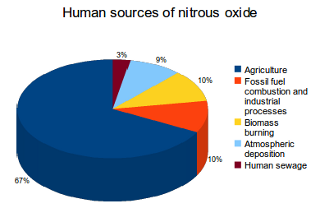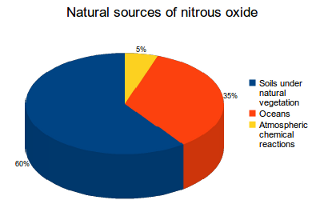Nitrous oxide emissions gets produced by both natural and human sources. Important natural sources include soils under natural vegetation and the oceans. Natural sources create 62% of total emissions. Important human sources come from agriculture, fossil fuel combustion and industrial processes. Human-related sources are responsible for 38% of total emissions.
Human activities have added large quantities of reactive nitrogen compounds to the environment and have virtually doubled the mainly natural inputs existing at the beginning of the industrial age. But, a large part of this gets lost and cascades through the Earth's soils, water ways and atmosphere. This has increased nitrous oxide emissions by about 40-50% over pre-industrial levels.
Before the Industrial Revolution, the atmospheric concentration of nitrous oxide stayed in a safe range of levels because of natural sinks. But for a long time now human activities have been creating emissions much more rapidly than the Earth can remove them. Nitrous oxide levels are now higher today than at any other time during the last 800,000 years.
Nitrous Oxide Emissions: Human Sources
Since the Industrial Revolution, human sources of nitrous oxide emissions have been growing. Activities such as agriculture, fossil fuel combustion and industrial processes are the primary cause of the increased nitrous oxide concentrations in the atmosphere. Together these sources are responsible for 77% of all human nitrous oxide emissions. Other sources include biomass burning (10%), atmospheric deposition (9%) and human sewage (3%).
Figure 1: Source: IPCC Fourth Assessment Report: Climate Change 2007, Intergovernmental Panel on Climate Change.
Source: IPCC Fourth Assessment Report: Climate Change 2007, Intergovernmental Panel on Climate Change.
Agriculture
The largest human source of nitrous oxide emissions is from agriculture which accounts for 67%. Agriculture creates both direct and indirect emissions. Direct emissions come from fertilized agricultural soils and livestock manure (42%). While indirect emissions come from runoff and leaching of fertilizers (25%). Agriculture creates 4.5 million tonnes of nitrous oxide per year.
Because of the inefficiencies of nitrogen uptake by plants and animals, only about 10 to 15% of reactive nitrogen ever enters a human mouth as food. The rest is lost to the environment. Industrialized farming practices have worsened this loss and the result has been increased emissions. Because of this, agriculture is the most important human source of nitrous oxide emissions.
Fertilized agricultural soils
The use of synthetic fertilizer for agriculture is a major source of nitrous oxide emissions. Fertilizers help feed plants by adding nitrogen directly to soils. But soil bacteria also take advantage of this extra nitrogen and use it to produce the energy they need to live and grow. Microbial processes of nitrification and denitrification produce nitrous oxide which is then released into the atmosphere. Similarly, the use of manure as a fertilizer also leads to emissions from agricultural soils. Nitrous oxide can be created rapidly when soils are warm and moist while also containing a ready supply of reactive nitrogen.
Synthetic fertilizers cause a heavy strain on the environment as well as on the quality of the food produced. These synthetic chemicals are absorbed by the plants which are then absorbed by us. Apart from this, large quantities of natural gas are used to make synthetic fertilizers because it is the main ingredient. The production process also takes a lot of energy so their impact on climate change is actually larger when we factor this in.
Livestock manure
The storage and handling of livestock manure is another direct source of agricultural nitrous oxide emissions. When the manure of livestock is not used as a fertilizer or left in fields during grazing, it has to be kept for treatment and disposal in animal waste management systems. Many of these systems create conditions that are favorable for nitrous oxide producing bacteria.
The same microbial processes responsible for generating nitrous oxide in soils, nitrification and denitrification, are also responsible for the nitrous oxide emitted when the nitrogen in manure decomposes. So places like poultry, beef and dairy farms produce significant amounts of nitrous oxide.
Intensive livestock farming systems have low nitrogen use efficiency, creating large amounts of losses. Only a small fraction of the ingested nitrogen in animal feed (about 5-30%) is retained in milk, meat, and eggs. The bulk part, 70-95%, is lost via animal waste. This extra nitrogen gets added to the environment and is causing increases in nitrous oxide emissions.
Runoff and leaching of fertilizers
Runoff and leaching of fertilizers from agricultural soils are an indirect source of nitrous oxide. Rainfall or irrigation water causes part of the reactive nitrogen in fertilizers to either leach into groundwater or be washed away to drainage ditches, eventually flowing into connecting rivers, estuaries and coastal zones.
This increases nitrogen levels in these areas, which microbes break down causing greater nitrous oxide emissions. Overuse of fertilizers or excessive rainfall often make the effects of runoff and leaching even worse.
Emissions of nitrous oxide from rivers, estuaries and coastal waters are generally considered as human-caused because most of the reactive nitrogen entering these ecosystems is associated with agricultural activities.
Fossil fuel combustion and industrial processes
Fossil fuel combustion and industrial processes are an important source of nitrous oxide emissions. These two combined are responsible for 10% of human emissions which equals 700,000 tonnes of nitrous oxide per year.
Nitrous oxide is a by-product of fuel combustion in mobile and stationary sources. When any fossil fuel is burnt, part of the nitrogen that is in the fuel and surrounding air gets oxidized creating nitrous oxide emissions. The majority of stationary emissions come from coal fired power plants. As for mobile emissions, almost all of it comes from cars and trucks that are used to transport people and goods.
Industrial processes also causes nitrous oxide emissions. The two main industrial sources are the production of nitric and adipic acid. Nitric acid is an important ingredient for synthetic fertilizers, while adipic acid is primarily used for making synthetic fibers. For both of these acids, oxidization of nitrogen compounds during the production process creates nitrous oxide.
Biomass burning
A substantial amount of nitrous oxide is caused by biomass burning, which accounts for 10% of human-caused emissions. Biomass burning is the burning of living and dead vegetation. In these fires, some of the nitrogen in the biomass and surrounding air is oxidized creating nitrous oxide emissions.
Large open fires are mainly used by humans to destroy crop waste and clear land for agricultural or other uses. While natural wildfires can contribute to this, the great majority of biomass burning is caused by human beings. This creates 700,000 tonnes of nitrous oxide per year.
Atmospheric deposition
Atmospheric deposition is another substantial human source of nitrous oxide emissions. Human activities release nitrogen compounds into the air which eventually falls back down to the Earth's surface. This provides ecosystems with an extra source of available nitrogen which stimulates nitrifying and denitrifying microbes causing increased emissions. This creates 9% of human-caused emissions.
Vapors from fertilizers and smoke from fossil fuel or biomass burning contain reactive nitrogen gases. These gases eventually fall out of the atmosphere because either rain washes them out or they get attached to dust and pollen that settle to the ground. Atmospheric deposition produces 700,000 tonnes of nitrous oxide per year.
Human sewage
As with animal waste, human waste is a significant source of nitrous oxide emissions. Sewage plants and septic tanks are used to store and treat wastewater. Many of these systems create conditions that are favorable for nitrous oxide producing bacteria. Human sewage produces 3% of human emissions.
Bacteria use nitrification and denitrification processes to break down the nitrogen-based organic materials that is found in human waste (urea, ammonia, and proteins). This creates 200,000 tonnes of nitrous oxide per year.
Nitrous Oxide Emissions: Natural Sources
Apart from being created by human activities, nitrous oxide is also released into the atmosphere by natural processes. The Earth's soil, oceans and atmosphere are all natural sources of nitrous oxide emissions.
Human sources of nitrous oxide are smaller than natural emissions but they upset the balance in the nitrogen cycle that existed before the Industrial Revolution. The quantity of nitrous oxide produced by natural sources is completely offset by natural sinks and has been for thousands of years. Before the influence of humans, nitrous oxide levels were quite steady because of this natural balance.
Soils under natural vegetation are an important source of nitrous oxide, accounting for 60% of all naturally produced emissions. Other natural sources include the oceans (35%) and atmospheric chemical reactions (5%).
Figure 2: Source: IPCC Fourth Assessment Report: Climate Change 2007, Intergovernmental Panel on Climate Change.
Source: IPCC Fourth Assessment Report: Climate Change 2007, Intergovernmental Panel on Climate Change.
Soils under natural vegetation
The largest natural source of nitrous oxide is from soils under natural vegetation. This produces 60% of natural emissions. Uncultivated soils make up the majority of the Earth's land surface. So the nitrous oxide produced by microbes that break down nitrogen in these soils are considered natural sources.
Riparian and tropical rainforest soils are important contributors to this source because they have higher nutrient availability and moisture levels. This facilitates microbial nitrification and denitrification. Soils under natural vegetation create 6.6 million tonnes of nitrous oxide each year.
Oceans
An important natural source of nitrous oxide emissions comes from the oceans. Nitrous oxide producing microbes living in the ocean create these emissions. This produces 35% of natural emissions which equals 3.8 million tonnes of nitrous oxide per year.
Much of the nitrous oxide in the oceans arises from microbial activity in and around sinking particles, such as fecal pellets. These particles provide the anaerobic conditions necessary for denitrification, a process which creates nitrous oxide as a by-product.
Atmospheric chemical reactions
Chemical reactions in the atmosphere produce a significant amount of nitrous oxide emissions. The atmosphere acts as a source for nitrous oxide through the oxidation of ammonia which creates 5% of emissions.
Ammonia is a natural occuring gas in the atmosphere. The oceans, manure from wild animals as well as aging and rotting plants form the most important natural sources of ammonia in the air. The oxidization of ammonia from natural sources creates 600,000 tonnes of nitrous oxide per year.
More info:
Nitrous Oxide Emissions - US EPA
Nitrous oxide emissions - The World Bank Group


